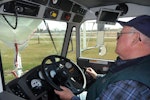Vertical integration gains in heavy trucks
OEMs make their engines standard in many models because that’s more profitable than selling those from vendors. And it guarantees parts and service business for their dealers. To protect their reputations, control warranty costs, and properly serve customers, they must be sure that their products perform well and are long- lasting, which they seem to be.
The engines are the 11- to 13-liter category, just the right size for heavy vocational trucks, which often run empty half the time and need to save weight. Thirteen-liter diesels are increasingly popular in highway tractors, because with modern combustion, air handling and exhaust techniques, they make as much power and torque as most operators want or need. For extra-heavy operations, some proprietary engines are 15 and 16 liters in displacement and more powerful.
Private branding is used by Paccar for its medium- and medium-heavy PX diesels, made by Cummins and otherwise sold as the ISB6.7 and ISL9. And Caterpillar uses Navistar’s N13 in its Cat Trucks, which Navistar assembles under contract. The N13 has SCR gear sourced from Cummins; Caterpillar’s okay with that, but not the idea of using an ISX15 as a big-bore option to replace the MaxxForce 15 program that Navistar canceled. The Cat C15 is no longer certified for on-road use, but an announcement on plans for a larger engine is supposed to come soon.
Cummins is the only independent engine supplier since Caterpillar left the truck-engine business at the end of 2009. Most OEMs offer Cummins diesels as options or as standard in some truck models. In some cases, OEMs offer a Cummins model if they don’t have one of that size or if customers demand it; a prime example is the ISX15, available from Navistar International, Volvo, Kenworth and Peterbilt, who have 13-liter models (and an 11 and 16 in Volvo’s case). KW and Pete also sell the ISX12, even though it competes with their own Paccar MX-13.
Freightliner offers the ISX12 and ISX15, and its sister OEM, Western Star, offers the ISL9 and ISX15, though they have proprietary 13-, 15- and 16-liter Detroit Diesels. This fits with Freightliner’s philosophy of giving customers more choices than other builders, and being more flexible with custom engineering. Yet Freightliner now has “integrated power train” options using Detroit-branded and -built engines, transmissions and axles.
The Detroit transmission is the relatively new DT12, an automated manual gearbox that has begun competing in Freightliners with Eaton’s UltraShift and the Cummins-Eaton Smart Advantage engine-automated transmission package. Will there be room in Freightliner’s crowded options book for the recently released Allison TC10 10-speed automatic? Maybe, maybe not. For now it’s offered only by Navistar. TC10 is not yet approved for vocational use.
Other proprietary automated transmissions are Volvo’s 12-speed I-Shift and Mack’s version, the mDrive. Either can be had only with Volvo and Mack engines, and the OEMs are encouraging I-Shift and mDrive use in vocational trucks. Volvo does sell the Eaton UltraShift with the Cummins ISX, as well as the Cummins-Eaton Smart Advantage, but these form a minority of its business. Caterpillar has its CX31 automatic available in the Cat Truck series, and more than half of all buyers take it; Caterpillar also offers Eaton’s UltraShift but not Allison automatics.
All other Class 8 OEMs offer Allison’s 6-speed full automatics. To medium-duty versions, Allison has added optional Fuel Sense refinements, including “managed acceleration”—controlling power to prevent hot-rodding—and shifting to neutral while the truck’s stopped, then back to drive when the brake’s released. These take load off the engine and save fuel.
Faced with the recession-caused slowdown, not many construction fleets have the latest diesels. But their reliability is improving, say managers at freight-hauling fleets who’ve been buying them. Use of SCR on most engines starting in 2010 allowed tuning for performance and economy, and they are saving fuel. Meanwhile, diesel particulate filters are holding up better, even if they remain trouble-prone. Managers report fewer problems with exhaust-gas recirculation equipment, but new problems with SCR apparatus that pumps and injects urea fluid into exhaust streams.





